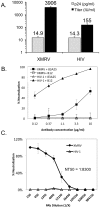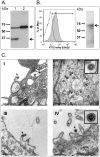Antibody responses against xenotropic murine leukemia virus-related virus envelope in a murine model
- PMID: 21494670
- PMCID: PMC3071813
- DOI: 10.1371/journal.pone.0018272
Antibody responses against xenotropic murine leukemia virus-related virus envelope in a murine model
Erratum in
- PLoS One. 2011;6(5). doi:10.1371/annotation/913fdc1e-877e-4c70-ac20-761d2d72400d
Abstract
Background: Xenotropic murine leukemia virus-related virus (XMRV) was recently discovered to be the first human gammaretrovirus that is associated with chronic fatigue syndrome and prostate cancer (PC). Although a mechanism for XMRV carcinogenesis is yet to be established, this virus belongs to the family of gammaretroviruses well known for their ability to induce cancer in the infected hosts. Since its original identification XMRV has been detected in several independent investigations; however, at this time significant controversy remains regarding reports of XMRV detection/prevalence in other cohorts and cell type/tissue distribution. The potential risk of human infection, coupled with the lack of knowledge about the basic biology of XMRV, warrants further research, including investigation of adaptive immune responses. To study immunogenicity in vivo, we vaccinated mice with a combination of recombinant vectors expressing codon-optimized sequences of XMRV gag and env genes and virus-like particles (VLP) that had the size and morphology of live infectious XMRV.
Results: Immunization elicited Env-specific binding and neutralizing antibodies (NAb) against XMRV in mice. The peak titers for ELISA-binding antibodies and NAb were 1:1024 and 1:464, respectively; however, high ELISA-binding and NAb titers were not sustained and persisted for less than three weeks after immunizations.
Conclusions: Vaccine-induced XMRV Env antibody titers were transiently high, but their duration was short. The relatively rapid diminution in antibody levels may in part explain the differing prevalences reported for XMRV in various prostate cancer and chronic fatigue syndrome cohorts. The low level of immunogenicity observed in the present study may be characteristic of a natural XMRV infection in humans.
Conflict of interest statement
Figures




Similar articles
-
Development and application of a high-throughput microneutralization assay: lack of xenotropic murine leukemia virus-related virus and/or murine leukemia virus detection in blood donors.Transfusion. 2012 Feb;52(2):332-42. doi: 10.1111/j.1537-2995.2011.03519.x. Transfusion. 2012. PMID: 22239212 Free PMC article.
-
No association of xenotropic murine leukemia virus-related virus with prostate cancer or chronic fatigue syndrome in Japan.Retrovirology. 2011 Mar 17;8:20. doi: 10.1186/1742-4690-8-20. Retrovirology. 2011. PMID: 21414229 Free PMC article.
-
Characterization of retroviral and lentiviral vectors pseudotyped with xenotropic murine leukemia virus-related virus envelope glycoprotein.Hum Gene Ther. 2010 Dec;21(12):1665-73. doi: 10.1089/hum.2010.063. Epub 2010 Sep 17. Hum Gene Ther. 2010. PMID: 20507233 Free PMC article.
-
Distribution of xenotropic murine leukemia virus-related virus (XMRV) infection in chronic fatigue syndrome and prostate cancer.AIDS Rev. 2010 Jul-Sep;12(3):149-52. AIDS Rev. 2010. PMID: 20842203 Review.
-
Lack of evidence for a role of xenotropic murine leukemia virus-related virus in the pathogenesis of prostate cancer and/or chronic fatigue syndrome.Virus Res. 2012 Jul;167(1):1-7. doi: 10.1016/j.virusres.2012.04.004. Epub 2012 Apr 15. Virus Res. 2012. PMID: 22531412 Review.
Cited by
-
No evidence for xenotropic murine leukemia-related virus infection in Sweden using internally controlled multiepitope suspension array serology.Clin Vaccine Immunol. 2012 Sep;19(9):1399-410. doi: 10.1128/CVI.00391-12. Epub 2012 Jul 11. Clin Vaccine Immunol. 2012. PMID: 22787191 Free PMC article.
-
Infection of female primary lower genital tract epithelial cells after natural pseudotyping of HIV-1: possible implications for sexual transmission of HIV-1.PLoS One. 2014 Jul 10;9(7):e101367. doi: 10.1371/journal.pone.0101367. eCollection 2014. PLoS One. 2014. PMID: 25010677 Free PMC article.
-
No detection of the retrovirus xenotropic murine leukemia virus-related virus in individuals with hemophilia.Transfus Med Hemother. 2013 Feb;40(1):32-5. doi: 10.1159/000345661. Epub 2013 Jan 3. Transfus Med Hemother. 2013. PMID: 23637647 Free PMC article.
-
Identification of XMRV infection-associated microRNAs in four cell types in culture.PLoS One. 2012;7(3):e32853. doi: 10.1371/journal.pone.0032853. Epub 2012 Mar 16. PLoS One. 2012. Retraction in: PLoS One. 2013 Jun 17;8(6). doi: 10.1371/annotation/f9aef9a9-5488-4492-8b8c-1cdded2e3d79. PMID: 22438885 Free PMC article. Retracted.
References
Publication types
MeSH terms
Substances
Grants and funding
LinkOut - more resources
Full Text Sources
Other Literature Sources
Research Materials

